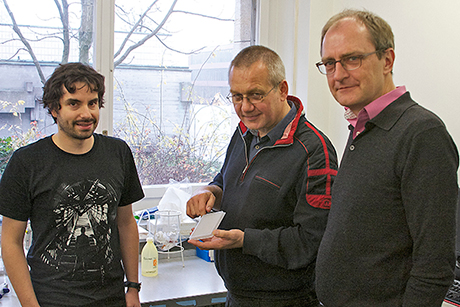Navigation auf uzh.ch
Navigation auf uzh.ch

When microbiologist Peter Sander talks about tuberculosis, you quickly realize why research into this disease is so urgently required: two billion people – or nearly a third of the world's population – carry the infectious agent Mycobacterium tuberculosis, ten million fall sick every year, and 1.5 million die as a result. “Tuberculosis tops the global ranking list of deadly infectious diseases,” he says.
Although the causative agent was isolated by Robert Koch as far back as the 19th century, and a number of antibiotics have been developed, there has been no success in decisively curbing the disease. “One reason for this is resistance to antibiotics,” says Sander. This renders many medications ineffective and results in protracted treatment. The situation with multidrug-resistant bacteria is particularly problematic. In such cases only cocktails of antibiotics delivered intravenously over several months can offer any help – if at all.
When the possibility arose in 2012 for a cooperation project with the Basel-based company Roche, the microbiologist from the Institute of Medical Microbiology therefore did not need to think twice. “The collaboration is based on a partnership agreement between the pharmaceuticals firm and the Universities of Zurich, Basel, and Bern,” says Patrick Sticher from the technology transfer organization Unitectra. With its EIN (Extending the Innovation Network) program, Roche supports innovative research by providing financial contributions and in-kind support, and receives access rights to the findings in return.
Sander saw this cooperation as offering the opportunity to gain access to the company's massive compound libraries, where he could search for new antibiotics. “Roche has hundreds of thousands of substances, and our Institute has the expertise needed to test their efficacy against tuberculosis,” says Sander. He therefore submitted a proposal, and both Roche and the EIN evaluation committee were convinced.
The three-year project has now borne its first fruit: the team has identified a small number of promising substances from Roche's extensive compound library that show significant potential as antibiotics against tuberculosis. Peter Sander carried out the biological tests together with his doctoral candidates Michael Dal Molin, Petra Selchow, and other employees, supported by the chemists and IT staff at Roche.
This required a multi-tier screening process, which ultimately narrowed down a small number of substances usable as potential antibiotic agents. “We've worked for three years on this, and analyzed some 800,000 reactions,” say Sander and Dal Molin, looking back. The next step will be to develop the promising antibiotic candidates into drugs.
The screening and identification of new active substances is only the first step in a long process toward a marketable antibiotic, a process that will need additional partners. Various options are being discussed with Roche, such as the National Research Program 72 on “Antimicrobial Resistance” which is still open for project proposals. There are also other possibilities that are being looked into.
It is still to be determined at this stage what exactly will happen with the antibiotic candidates. One thing is certain, however: new active agents are needed to conquer tuberculosis. The WHO has set itself ambitious targets: it wants to halve the number of new cases in the next twenty years and then to achieve full elimination of tuberculosis by 2050.